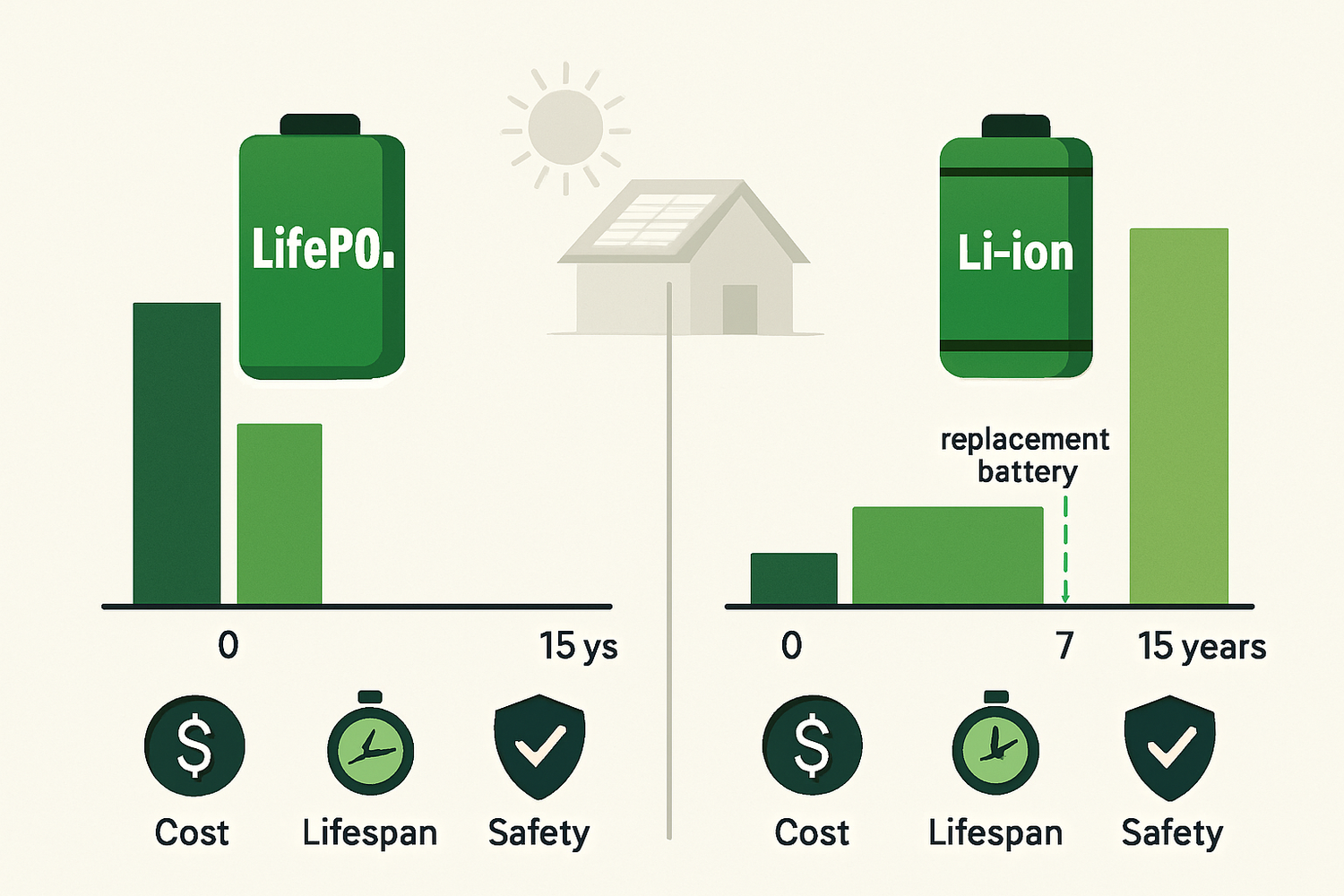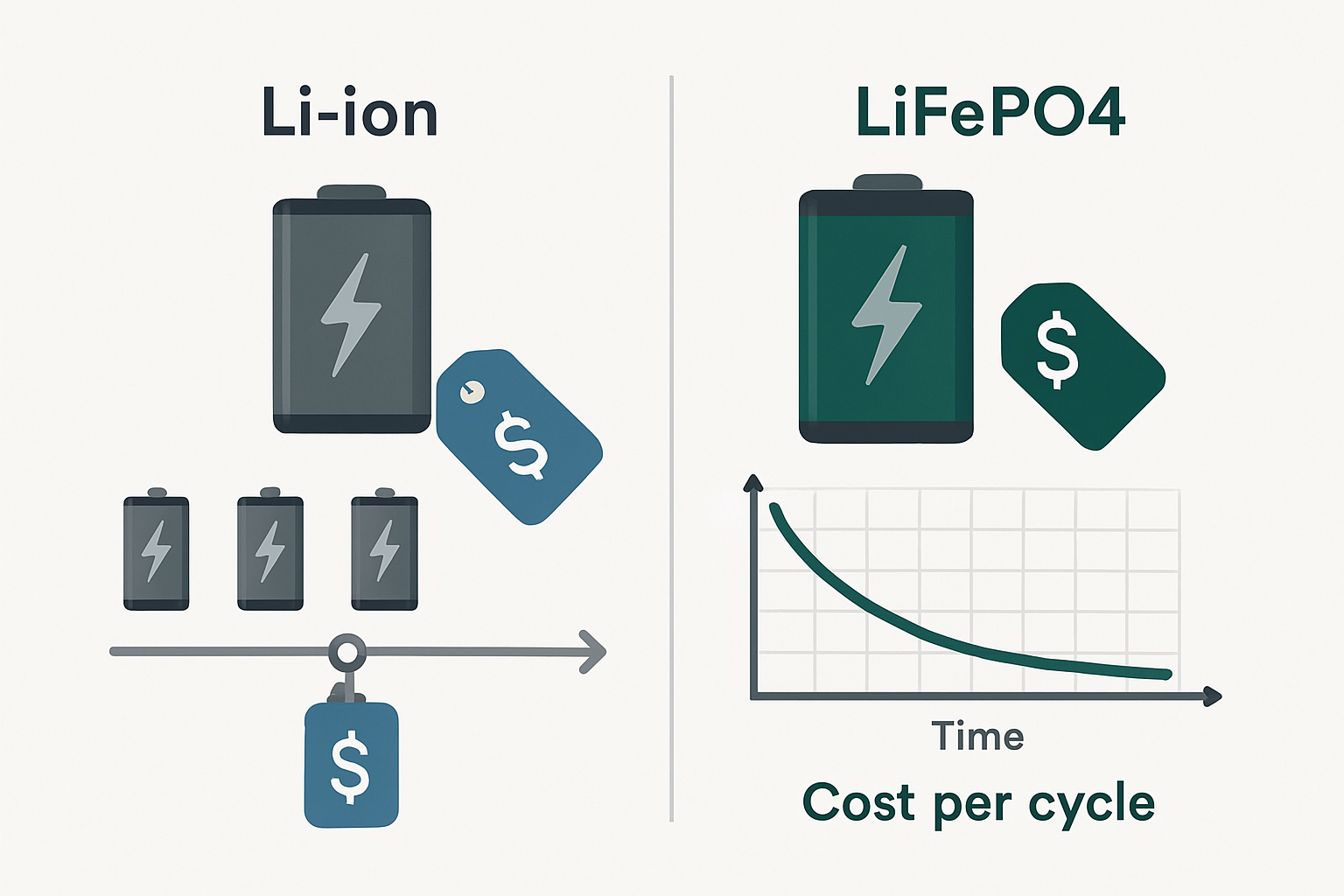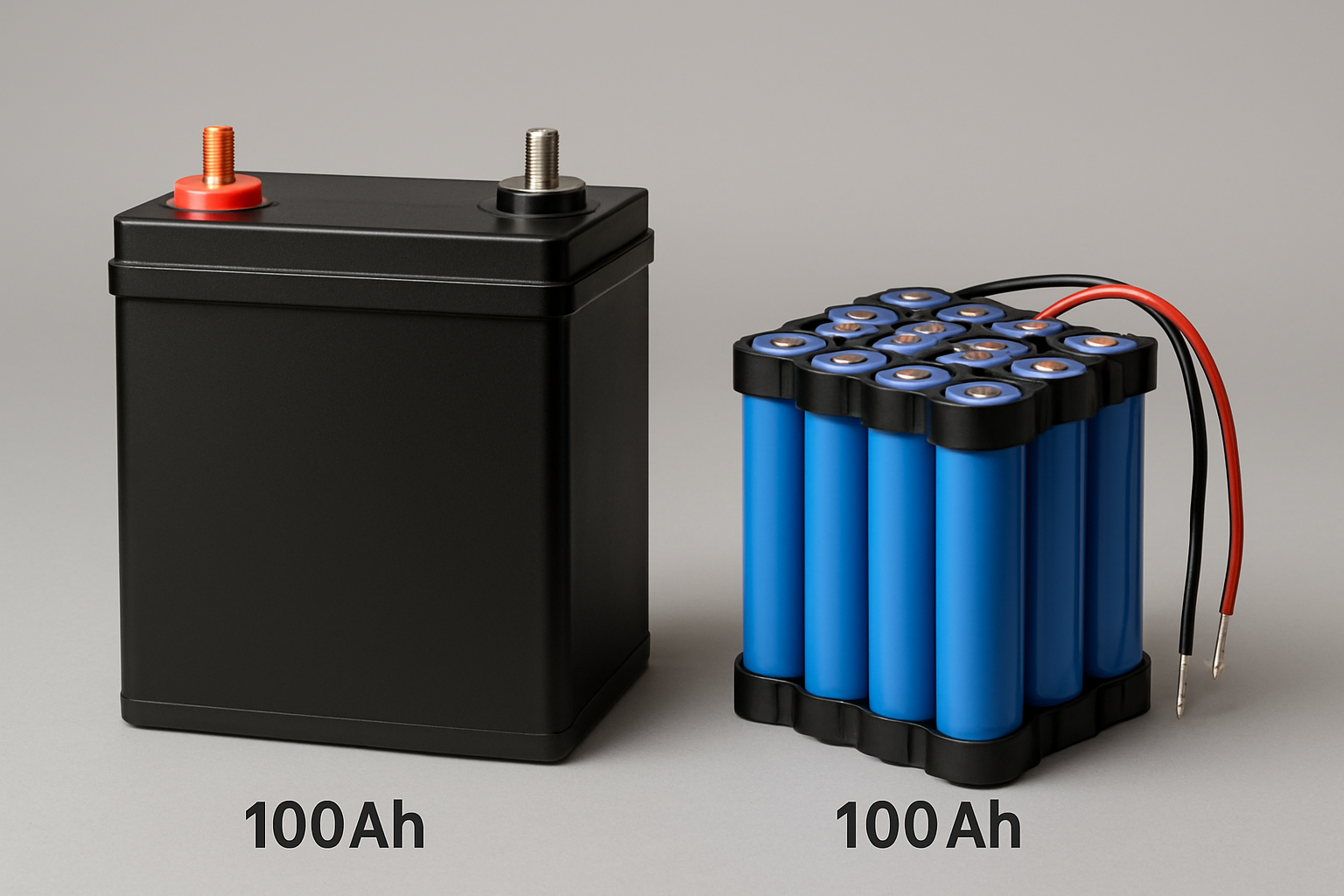Choosing a battery for an energy storage system involves looking past the initial price tag. The real measure of a battery's worth is its long-term value, determined by its lifespan, performance, and safety. Lithium Iron Phosphate (LiFePO4) and other lithium-ion chemistries, like Nickel Manganese Cobalt (NMC), are leading options, but they offer vastly different propositions for long-term return on investment (ROI). A careful battery ROI comparison reveals that the most cost-effective solution is not always the one with the lowest upfront cost.
Understanding the Fundamental Differences in Chemistry
The long-term value and performance of a battery are rooted in its core chemistry. The atomic structure of the cathode material dictates its stability, lifespan, and safety profile, creating a clear distinction between LiFePO4 and other Li-ion types.
LiFePO4 (Lithium Iron Phosphate): The Stability Champion
LiFePO4 batteries utilize a crystalline structure known as an olivine, where atoms are held together by strong covalent bonds. This structure is exceptionally stable, particularly under thermal stress. It does not release oxygen easily, which is a key factor in preventing thermal runaway—a dangerous chain reaction that can lead to fires. This inherent stability makes LiFePO4 a remarkably safe and durable chemistry, ideal for stationary applications like home energy storage.
Li-Ion (NMC): The Energy Density Leader
NMC batteries, a common type of lithium-ion cell, use a layered oxide structure combining nickel, manganese, and cobalt. This chemistry achieves a higher energy density, meaning it can store more energy in a smaller, lighter package. While this is a significant advantage for portable electronics and some electric vehicles where space and weight are critical, this structure is less stable thermally. It has a lower threshold for thermal runaway, requiring more complex and costly battery management systems (BMS) to operate safely.
Cycle Life and Longevity: The Core of Long-Term Value
For any significant investment, durability is paramount. In the context of batteries, this is measured by cycle life—the number of charge and discharge cycles a battery can endure before its capacity significantly degrades. This metric is central to calculating the Lifepo4 cost effectiveness and its overall investment return.
Comparing Cycle Counts and Depth of Discharge (DoD)
LiFePO4 technology consistently outperforms other lithium-ion chemistries in longevity. A typical LiFePO4 battery can deliver between 3,000 and 7,000 cycles, while an NMC battery generally offers 1,000 to 2,000 cycles. This means a LiFePO4 battery can last several times longer under similar usage conditions. Furthermore, LiFePO4 batteries are more resilient to deep discharges. You can regularly use a higher percentage of their stored energy without substantially shortening their lifespan, giving you more usable capacity.
Calculating Total Cost of Ownership (TCO)
Total Cost of Ownership provides a more accurate financial picture than initial price alone. It considers the upfront cost, lifespan, and energy delivered over the battery's entire service life. The International Energy Agency (IEA) notes that while battery costs have fallen dramatically, focusing on longevity is critical for stationary storage. LiFePO4's longer cycle life means you avoid the cost and hassle of replacement, leading to a much lower cost per kilowatt-hour (kWh) over time.
| Metric | LiFePO4 Battery | NMC Battery |
|---|---|---|
| Initial Cost | $4,000 | $3,200 |
| Cycle Life | 6,000 cycles | 1,500 cycles |
| Total Energy Delivered | 60,000 kWh | 15,000 kWh |
| Replacements Over 15 Years | 0 | 3 |
| Total 15-Year Cost | $4,000 | $9,600 ($3,200 x 3) |
| Cost per kWh | $0.067 | $0.64 |
Disclaimer: This table is for illustrative purposes. Actual costs and performance may vary based on specific products and usage conditions. This is not financial advice.
Performance and Efficiency Under Real-World Conditions
A battery's value is also determined by how it performs in the environments where it will actually be used. Factors like temperature stability and usable capacity directly impact its efficiency and reliability, influencing the overall lithium ion investment return.
Thermal Stability and Operating Temperatures
LiFePO4 batteries operate safely across a broader temperature range compared to NMC batteries. Their stable chemistry makes them far less susceptible to overheating, a critical safety feature for systems installed in garages, basements, or outdoor enclosures where temperature is not always controlled. According to the U.S. Department of Energy, all battery systems must meet stringent safety standards, but LiFePO4's chemistry provides an inherent advantage.
Usable Capacity and Efficiency Ratings
Efficiency is about more than just storing energy; it's about getting that energy back when you need it. As detailed in a comprehensive guide on solar storage performance, metrics like round-trip efficiency are crucial for calculating the actual energy you recover from your system. LiFePO4 batteries typically maintain high efficiency throughout their cycle life. Their tolerance for a deep depth of discharge means you can access more of the nameplate capacity without accelerating degradation, giving you more usable energy day after day.
Final Considerations for Your Investment
When evaluating long-term value batteries, the evidence points toward a clear conclusion. While some lithium-ion chemistries offer higher energy density, their shorter lifespan, higher replacement costs, and narrower safety margins make them a less sound investment for stationary storage. Reports from the International Renewable Energy Agency (IRENA) highlight that falling costs and improving performance are making battery storage increasingly viable, but the choice of chemistry is crucial for long-term success. LiFePO4 technology, with its superior cycle life, inherent safety, and lower total cost of ownership, provides a more reliable and financially prudent path toward energy independence. It delivers a stronger return on investment by minimizing future costs and maximizing performance over many years.
Frequently Asked Questions
Why does LiFePO4 have a lower energy density?
The lower energy density of LiFePO4 is a direct result of its stable olivine chemical structure. The strong bonds that make the battery safe and long-lasting also mean it can't pack as much energy into the same physical space as the layered-oxide structure of NMC batteries. This is a deliberate trade-off of energy density for safety and longevity.
Is the higher upfront cost of LiFePO4 always justified?
For applications where longevity, safety, and cycle count are the primary concerns—such as in a home solar energy storage system—the higher initial cost is almost always justified by a significantly lower total cost of ownership. For applications where weight and space are the top priorities and the device has a shorter expected life, such as in drones or power tools, a higher-density chemistry like NMC may be more suitable.
How does safety impact the long-term value of a battery?
Safety is a critical component of long-term value. A safer chemistry like LiFePO4 reduces the risk of property damage from fire or malfunction. It also requires less complex and costly thermal management and safety systems, which lowers the overall system cost and complexity. This enhanced safety and reliability contribute directly to a better and more secure return on investment.





Leave a comment
All comments are moderated before being published.
This site is protected by hCaptcha and the hCaptcha Privacy Policy and Terms of Service apply.